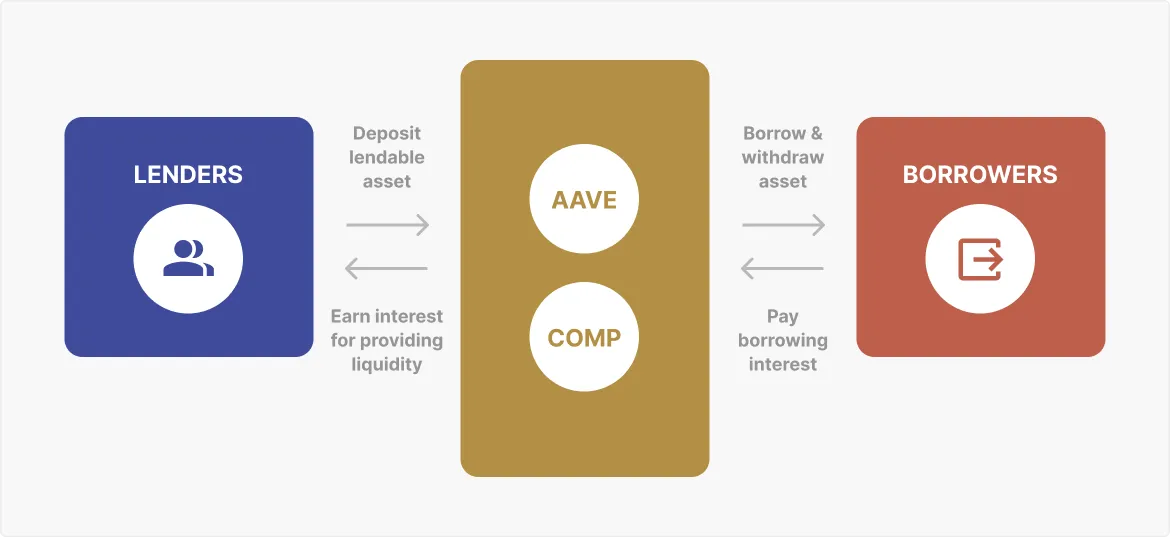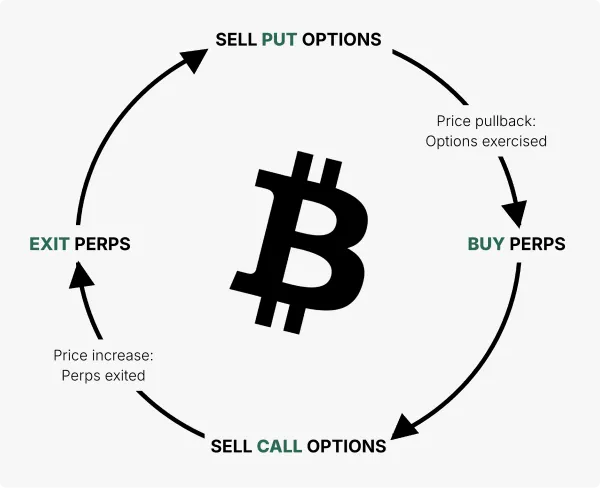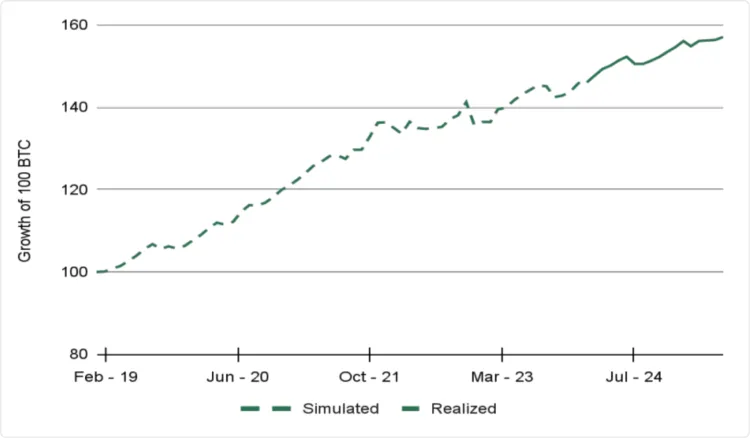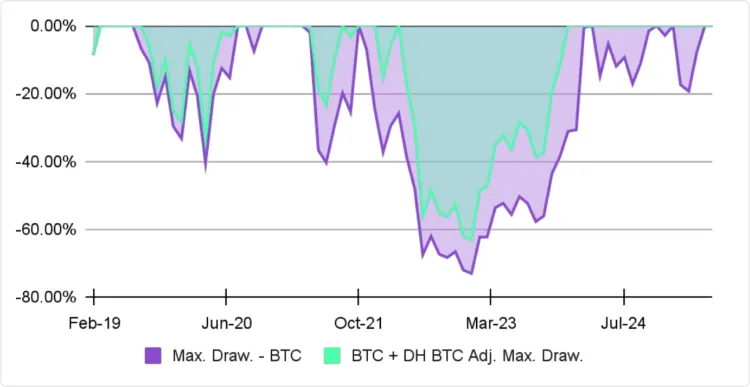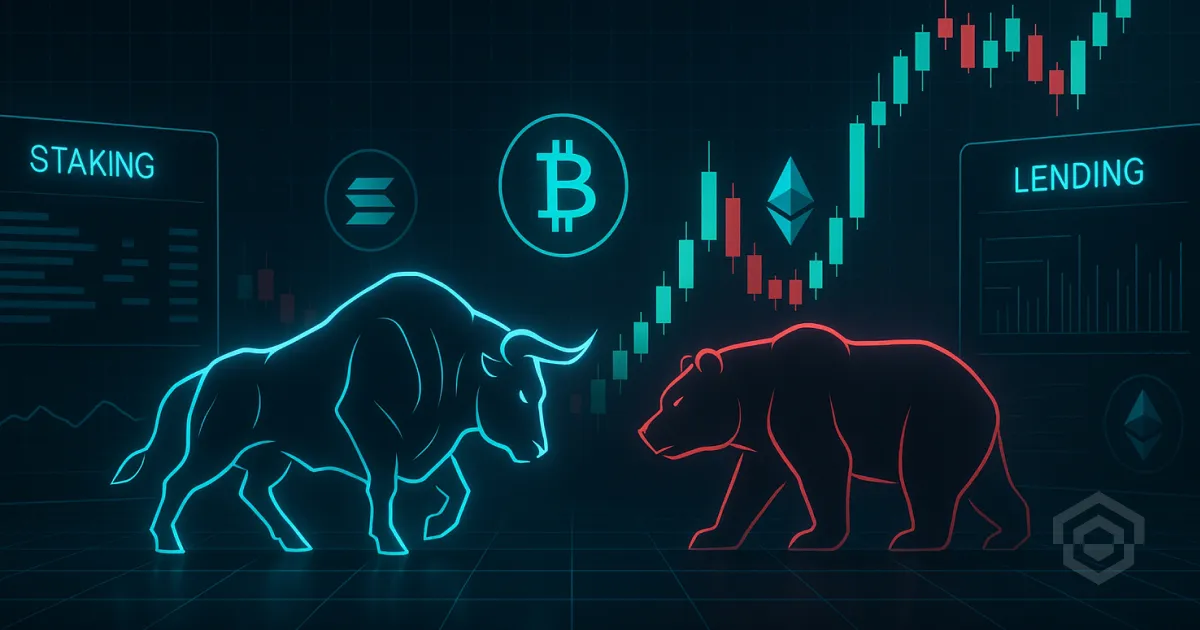

Types of crypto yield strategies: Staking, lending, and options explained | AI generated image by XBTO
Types of crypto yield strategies: Staking, lending, and options explained | AI generated image by XBTO
Introduction
Unlike traditional markets, cryptocurrencies offer unique opportunities to earn passive income through strategies like staking, lending, and options trading. These methods allow investors to generate yield while navigating the volatility of the crypto market. This article explores these three primary yield generation strategies, providing a detailed, accessible, and trustworthy guide to help both novice and experienced investors understand their mechanics, benefits, and risks.
What is yield generation in crypto?
Yield generation in crypto refers to earning passive income by utilizing digital assets in various financial mechanisms. Yield generation mechanisms underpin a wide range of yield opportunities in the crypto ecosystem, allowing investors to access different ways to earn returns. These investment strategies capitalize on blockchain technology and decentralized finance (DeFi) protocols to offer returns that often outpace traditional savings accounts or fixed-income investments. The three most prominent methods - staking, lending, and options trading - each operate differently but share the common goal of generating income from crypto holdings.
As the crypto market matures, these strategies have gained traction due to their accessibility and potential for high returns. Investors can earn yield through approaches such as staking, lending, and participating in DeFi protocols. Yield farming refers to a DeFi practice where users deposit tokens into liquidity pools to earn rewards, often in the form of governance tokens or APY. However, it’s important to note that yield generation is not risk- free - the returns are generated by underlying economic activities.
For example, when you earn 5% interest on a crypto savings account, it'’s because the platform is lending your assets to others or investing them elsewhere to generate that return (minus fees).
Similarly, staking rewards come from the network’s issuance of new tokens or fees. Every yield strategy has trade-offs in terms of risk, liquidity, and return. Yield farming strategies vary widely, and understanding how the yield farming process works is key for optimizing returns. In the context of crypto yield products, it'’s important to distinguish between annual percentage rate (APR), which measures simple interest, and annual percentage yield (APY), which reflects the compounded returns earned over a year.
Every yield strategy has trade-offs in terms of risk, liquidity, and return. Capital efficiency also plays a significant role, as strategies that maximize the use of invested assets can increase potential returns but may also introduce additional risks. The yield farming process typically involves a series of steps: depositing tokens into DeFi protocols, earning rewards such as governance tokens or interest, and participating in these protocols to generate passive income.
An investor's risk tolerance should guide their choice of investment strategy, helping them decide between fixed or variable returns and the level of exposure to market volatility.
As a beginner, understanding these trade-offs is crucial: higher yields, such as those seen in crypto yield farming, often mean higher risk, whereas moderate, stable yields might be more sustainable.
Investment strategies in crypto can range from simple staking to more complex approaches like crypto yield farming, each with different yield farming returns and risk profiles.
How yield generation works (CeFi Focus)
Yield generation in CeFi typically occurs through a few well-established mechanisms. Here are the most common methods by which centralized platforms help you earn crypto yield:
Crypto lending is often regarded as the original engine of crypto yield. In a CeFi context, this usually means using a crypto savings account or lending platform. You deposit your cryptocurrencies (or stablecoins) into an account, and the platform lends those assets out to borrowers (such as retail borrowers, institutional traders, or market makers) at a higher rate. In return, you receive a portion of the interest as your yield. This is very similar to how a traditional bank account works – except the interest rates in crypto can be more attractive than those in a typical bank, due to higher demand and risk in crypto lending markets.
- How it works: You create an account with a trusted CeFi platform, transfer assets (e.g. Bitcoin, Ethereum, USDC stablecoin), and opt into their earning program. The platform may offer either a flexible rate (variable APY that can change with market conditions) or a fixed term rate (e.g. lock up your funds for 1–3 months for a set APY). For example, some platforms in 2025 offer around 5%–15% APY on stablecoins with flexible access, whereas locking up funds for longer might yield more. The interest accrues over time – often daily or weekly – and you can withdraw your assets (plus earned interest) as per the platform’s terms.
- Benefits: Higher yields: They provide a steady, predictable income without needing you to trade or actively manage assets. More attractive returns compared to staking or interest-bearing products, appealing to yield-focused investors. Decentralized & permissionless: Fully automated platforms run by smart contracts and available to all who meet the lending or borrowing requirements. You also retain ownership of your crypto (you’re not selling it, just lending it), so you can benefit from any price appreciation while earning interest. This approach suits both individual HODLers and institutions seeking a low-effort way to get yield on idle assets. In fact, by Q1 2025 the CeFi lending market has grown substantially (active loan volumes exceeded $22 billion) as many investors see it as a convenient avenue for passive returns (Source: Crypto.com). Collateralized lending: Borrowers post collateral, mitigating default risk.
- Risks: The major risk in CeFi lending is counterparty risk - you must trust the platform to manage funds responsibly and stay solvent. If the platform or its borrowers fail (as happened in some high-profile collapses in 2022), you could lose your deposits. Additionally, CeFi interest rates can fluctuate with market demand, and sometimes platforms impose withdrawal limits or delays during market stress. Platform security (risk of hacking) is another concern. It’s crucial to use reputable, well-audited platforms and not chase abnormally high rates that might indicate undue risk. Diversifying across platforms and keeping an eye on the platform’s health (e.g. proof of reserves or regulatory compliance) can mitigate some risks.
Staking is the process of participating in a proof-of-stake (PoS) blockchain network by locking up tokens to help secure the network, for which you earn rewards. While staking can be done independently (running your own validator node), many beginners and even institutions prefer to use centralized staking services for convenience. These services can be part of major exchanges or custodial platforms that handle the technical requirements for you.
- How it works: You hold a PoS cryptocurrency (such as Ether (ETH), Solana (SOL), Cardano (ADA), etc.) in a platform that offers staking. The platform pools user holdings to run validator nodes or delegate to validators. In return, you receive staking rewards, often distributed periodically (e.g. daily or weekly). For instance, centralized exchanges might offer staking yields on ETH or ADA with estimated annual yields in the range of a few percent, depending on network rates. Some platforms even offer “liquid staking” tokens - these are tokens that represent your staked assets and can be traded or used elsewhere while you continue earning rewards (though liquid staking is more commonly a DeFi concept now being adopted by CeFi).
- Benefits: Staking through a CeFi service is beginner-friendly - there's no need to maintain a node, worry about uptime or technical setup, or meet large minimum token requirements (like needing 32 ETH to solo-stake on Ethereum). You can often stake with a few clicks, and the platform takes care of compounding rewards and technical maintenance. Staking yields are generally seen as lower-risk passive income because they're the native reward of the blockchain for its operation, and they tend to be regular and predictable. For example, staking yields might range from ~4% to 10% APY depending on the coin and prevailing network conditions.
- Risks: Despite its simplicity, staking via CeFi carries some of the same risks as other centralized services. Custodial risk means you must trust the provider with your tokens; if the platform is compromised or mismanages funds, you could lose your staked assets. Additionally, some staking services impose a lock-up period. During lock-up, you can’t access your tokens, which is a liquidity risk. There’s also the risk of “slashing” on certain networks, if the validator misbehaves (double-signs or goes offline), a portion of staked funds can be forfeited. Reputable platforms strive to manage and cover such risks, but it's worth understanding that staking is not without potential downsides. Finally, the value of the staked token can fluctuate; a 5% annual reward might be negated by a 20% drop in token price, so always consider the underlying asset’s outlook.
Options Trading: Leveraging derivatives for yield
What are crypto options?
Crypto options are derivative contracts that grant the holder the right, but not the obligation, to buy (call) or sell (put) an underlying cryptocurrency at a predetermined strike price before or at expiration. Platforms like Deribit facilitate options trading for assets such as Bitcoin and Ethereum, offering sophisticated strategies to turn market volatility into opportunities.
How options work for yield
Options trading can generate yield through an actively managed, options-based strategy designed to accumulate Bitcoin at attractive levels while generating consistent income. This approach, as illustrated by XBTO’s "Diamond Hands" strategy, involves:
- Selling Put options: Collecting premiums to acquire Bitcoin during market pullbacks. If exercised, the strategy enters long Bitcoin via perpetual futures, increasing exposure at favorable prices.
- Selling Call options: Enhancing yield by managing upside risk on excess exposure, with positions reduced as markets recover.
- Dynamic cycle: The strategy restarts with fresh put selling, leveraging real-time volatility monitoring and precision execution across strikes, maturities, and sizes using proprietary technology and direct exchange connectivity.
- Perpetual Futures (PERPS) Management: Buying PERPS during price increases and exiting them during pullbacks, optimizing the portfolio based on dynamic risk frameworks, option profiles, and market conditions.
Benefits of options trading
Options trading can generate yield through an actively managed, options-based strategy designed to accumulate Bitcoin at attractive levels while generating consistent income. This approach, as illustrated by XBTO’s "Diamond Hands" strategy, involves:
- High yield potential: Premiums from selling options can yield 5-7% annualized returns (e.g., Diamond Hands NAV grew 7.19% p.a. as of 2025), with low drawdowns (-3.86% max).
- Volatility advantage: Real-time monitoring of the volatility surface transforms market fluctuations into profit opportunities.
- Low-Risk accumulation: The strategy balances yield generation with coin accumulation, achieving a Sortino ratio of 2.18.
Risks of options trading
- Complexity: Requires expertise in dynamic risk management, market structure, and execution timing.
- Market risk: Significant price swings can impact PERPS and option outcomes. Options trading carries significant risks and can increase an investor's risk exposure if not managed properly.
- Liquidity risk: Dependence on specialized infrastructure to minimize slippage and structural inefficiencies.
Case study
Diamond Hands is an actively managed strategy that aims to accumulate coins at favorable levels and generate yield in Bitcoin with modest risk.
Investing existing BTC holdings in a BTC-denominated accumulation strategy not only generates yield but also strategically acquires additional Bitcoin at favorable prices during market pullbacks. This approach can enhance both absolute and risk-adjusted returns in USD terms by growing BTC holdings over time.
Best practices for options trading
- Utilize platforms like Deribit with advanced tools for real-time data and trade oversight.
- Employ trend-following and risk/reward analysis to determine optimal entry and exit points.
- Partner with professional crypto asset managers to access to exclusive digital investment opportunities, institutional-quality deals, and sophisticated yield-generation techniques not easily available to individual investors.
The full breakdown
In our first article, "Navigating Crypto Volatility: The Advantages of Active Management," we explored how the high volatility and low correlation of digital assets with traditional asset classes create unique opportunities for active managers. We discussed how these characteristics enable active managers to execute tactical trading strategies, capitalizing on short-term price movements and market inefficiencies. Building on that foundation, we now turn our attention to the unique market microstructure of digital assets.
Conducive market microstructure of digital assets
The market microstructure of digital assets - a framework that defines how crypto trades are conducted, including order execution, price formation, and market interactions - sets the stage for active management to thrive. This unique ecosystem, characterized by its continuous trading hours, diverse trading venues, and substantial market liquidity, offers several advantages for active management, providing a fertile ground for sophisticated investment strategies.
24/7/365 market access
One of the defining characteristics of digital asset markets is their continuous, round-the-clock operation.
Unlike traditional financial markets that operate within specific hours, cryptocurrency markets are open 24 hours a day, seven days a week, all year round. This continuous trading capability is particularly advantageous for active managers for several reasons:
- Immediate response to market events: Unlike traditional markets that close after regular trading hours, digital asset markets allow managers to react immediately to breaking news or events that could impact asset prices. For instance, if a significant economic policy change occurs over the weekend, managers can adjust their positions in real-time without waiting for markets to open.
- Managing volatility: Continuous trading provides more opportunities to capitalize on price movements and volatility. Active managers can take advantage of this by implementing strategies such as short-term trading or hedging to mitigate risks and lock in gains whenever market conditions change. For instance, if there’s a sudden drop in the price of Bitcoin, managers can quickly sell their holdings to minimize losses or buy in to capitalize on the lower prices.
Variety of trading venues
The proliferation and variety of trading venues is another crucial element of the digital asset market structure. The extensive landscape of over 200 centralized exchanges (CEX) and more than 500 decentralized exchanges (DEX) offers a wide array of platforms for cryptocurrency trading. This diversity is beneficial for active managers in several ways:
- Risk management and diversification: By spreading trades across various exchanges, active managers can mitigate counterparty risk associated with any single platform. Additionally, the ability to trade on both CEX and DEX platforms allows managers to diversify their strategies, incorporating different levels of decentralization, regulatory environments, and security features.
- Arbitrage opportunities: Different venues often exhibit price discrepancies, presenting arbitrage opportunities. For example, managers can buy an asset on one exchange at a lower price and sell it on another where the price is higher, thus generating risk-free profits.
- Access to diverse liquidity pools: Multiple trading venues provide access to diverse liquidity pools, ensuring that managers can execute large trades without significantly impacting the market price.
Spot and derivatives markets (Variety of instruments)
The seamless integration of spot and derivatives markets within the digital asset space presents a considerable advantage for active managers. With substantial liquidity in both markets, they can implement sophisticated trading strategies and manage risk more effectively.
For instance, as of August 8 2024, Bitcoin (BTC) boasts a daily spot trading volume of $40.44 billion and an open interest in futures of $27.75 billion. Additionally, derivatives such as futures, options, and perpetual contracts enable managers to hedge positions, leverage trades, and employ complex strategies that can amplify returns.

Overall, the benefits for active managers include:
- Hedging and risk management: Derivatives offer a powerful tool for hedging against unfavorable price movements, enabling more efficient risk management. For instance, a manager holding a substantial amount of Bitcoin in the spot market can use Bitcoin futures contracts to safeguard against potential price drops, thereby enhancing risk control.
- Access to leverage: Managers can use derivatives to leverage their positions, amplifying potential returns while maintaining control over risk exposure. For instance, by employing options, a manager can gain exposure to an underlying asset with only a fraction of the capital needed for a direct spot purchase, thereby enabling more capital-efficient investment strategies.
- Strategic flexibility: By integrating spot and derivatives markets, managers can implement sophisticated strategies designed to capitalize on diverse market conditions. For instance, they may engage in volatility selling, where options are sold to generate income from market volatility, regardless of price direction. Additionally, managers can leverage favorable funding rates in perpetual futures markets to enhance yield generation. Basis trading, another strategy, involves taking offsetting positions in spot and futures markets to profit from price differentials, enabling returns that are independent of market movements.
Exploiting market inefficiencies
Digital asset markets, being relatively nascent, are less efficient compared to traditional financial markets. These inefficiencies arise from various factors, including regulatory differences, market segmentation, and varying levels of market maturity. For example:
- Pricing anomalies: Phenomena like the "Kimchi premium," where cryptocurrency prices in South Korea trade at a premium compared to other markets, create arbitrage opportunities. Managers can exploit these by buying assets in one market and selling them in another at a higher price.
- Exploiting mispricings: Active managers can identify and capitalize on mispricings caused by market inefficiencies, using strategies such as statistical arbitrage and mean reversion.
The unique aspects of the digital asset market structure create an exceptionally conducive environment for active management. Continuous trading hours and diverse venues provide the flexibility to react quickly to market changes, ensuring timely execution of trades. The availability of both spot and derivatives markets supports a wide range of sophisticated trading strategies, from hedging to leveraging positions. Market inefficiencies and pricing anomalies offer numerous opportunities for generating alpha, making active management particularly effective in the digital asset space. Furthermore, the ability to hedge and manage risk through derivatives, along with exploiting uncorrelated performance, enhances portfolio resilience and stability.
In our next article, we'll delve into the various techniques active managers employ in the digital asset markets, showcasing real-world use cases.
Read full disclaimer

